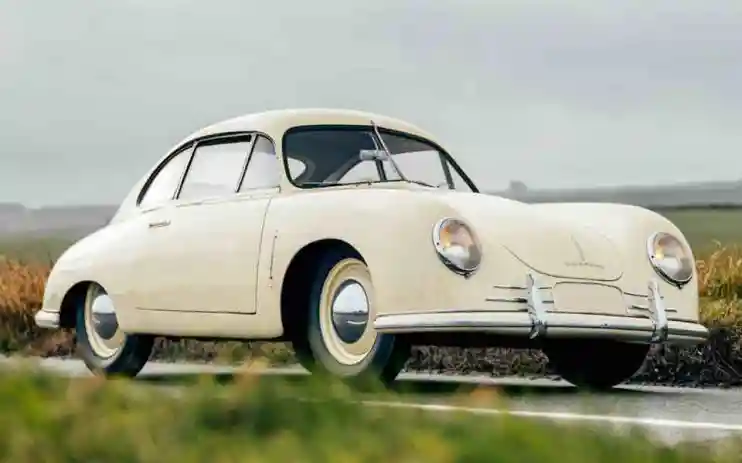1950 Porsche 356: Driving a piece of Porsche history

In 2024, a 0-60mph time of 23.5 seconds would make this the slowest car on sale. But in the late 1940s, with the ashes of World War Two still smouldering, the Porsche 356 epitomised speed and excitement. It was a symbol of better times ahead.
This is the start of Porsche’s sports car story. Strands of DNA that weave through everything from the 911 to the Mission X hypercar all lead back to here – and to the pretty Austrian village of Gmünd.
After Ferdinand Porsche designed the KdF-Wagen in 1938 (Adolf Hitler’s ‘Strength through Joy’ car, better known as the Volkswagen Beetle), his company was conscripted into Germany’s war effort, developing tanks and overseeing assembly of the Beetle-based Kübelwagen and Schwimmwagen military vehicles.
In 1943, as Allied bombs rained down on Stuttgart, Porsche upped sticks for Austria. Shielded by the immense Grossglockner mountain, a former sawmill in Gmünd provided the company with a safe haven and – after the hostilities ended – a fresh start.
A car for collectors
It was here that Ferdinand’s son ‘Ferry’ Porsche realised his dream to build a sports car. His first 356/1 prototype was a mid-engined roadster, but the production 356/2 moved the air-cooled engine behind the back axle (sound familiar?) to create space for luggage and a pair of occasional rear seats.
A total of 52 cars – 44 coupes and eight convertibles – were hand-built in Gmünd before Porsche returned to Stuttgart in 1951, where it has remained ever since. Today, only around 30 of these originals are thought to survive, making them sacred objects for Porsche obsessives. No wonder this one is valued at £3 million.
Currently for sale with Hertfordshire-based DK Engineering, chassis number 32 was first sold to a customer in Gothenburg, Sweden in late 1950. After a brief career as an endurance rally car – including the gruelling Midnight Sun Rally to the Arctic Circle – the 356 was eventually exported to the USA. It has since enjoyed a pampered retirement as part of several major Porsche collections.
Building on the Beetle
Waiting patiently next to a new 911 GT3 RS, the 356 looks almost apologetically understated. Its domed steel wheels are tucked deep within their arches, its central exhaust tailpipe hardly broader than a drinking straw. Apart from the chrome script across its nose, the car is also bereft of badges; the familiar Porsche crest wasn’t introduced until 1952.
Other quirks marking this out as a ‘Gmünd’ 356 include hand-beaten aluminium bodywork (Stuttgart-built cars used heavier, machine-pressed steel) and ‘semaphore’ indicators, which elevate from the front wings when you twist a bakelite button on the dashboard.
Lift the engine lid and you’ll find the 1,086cc flat-four from a VW Beetle, albeit with twin carburettors and high compression heads to increase output from 25hp to 40hp, plus 52lb ft of torque at 2,800rpm (for comparison, the equivalent figures for a new 911 Carrera are 385hp and 332lb ft). On one of Germany’s new-fangled autobahns, the 356 could reach an impressive top speed of 87mph, aided by its aerodynamic, teardrop-like shape. It just took a while to get there.
Getting into gear
There are no door locks (note to new owner: please keep your £3 million Porsche garaged), so I pull the pop-out handle then shuffle my thighs beneath the enormous steering wheel. Driver and front passenger share a softly-sprung, one-piece sofa, still trimmed in its original oxblood leather. There’s no adjustment for the seat, wheel or floor-hinged pedals, but luckily my 5ft 8in frame fits perfectly.
Prod a button hidden behind the dash panel and the engine blusters boisterously into life. As I slot the spindly wand into first gear, the syncopated beat of its horizontally opposed pistons is overlaid by a rising whine from the transmission. It sounds, well, very like a Beetle.
As I soon discover, changing gear is the trickiest part of driving the 356. Its four-speed manual has a conventional H-pattern gate, but you need to double de-clutch – i.e. release the clutch and shift to neutral – between every gear change. It’s the opposite of the wham-bam PDK ’box in most modern Porsches; your right arm and left leg need to work smoothly to avoid crunching the cogs, particularly on downshifts. Still, I’m enjoying the challenge of (sometimes) getting it right.
Like any 74-year-old car, the Porsche’s brakes also require some mental recalibration. There’s no servo assistance, so slowing down requires a concerted shove – and stopping with urgency simply means you push the pedal harder. However, with a kerb weight of only 745kg, the all-round drums don’t feel overwhelmed by their task.
All roads lead to Gmünd
On country roads, driving the 356 is a cerebral exercise in conserving momentum. Acceleration becomes glacial on even the mildest incline, while steeper hills require patience, second gear and a steady blare of revs. You can lean on the skinny tyres a little through corners, although the light steering and swing axle rear suspension don’t inspire huge confidence. Particularly when the price of gung-ho enthusiasm could stretch into seven figures.
Many people won’t understand the appeal of this car. It’s basic, slow, difficult to drive and you could buy 30 brand new 911s instead. However, for a Porsche enthusiast who had 930 Turbo and 959 posters blu-tacked to his bedroom wall, this was an experience I won’t forget.
The 356 offers robust, mechanical fun, but it’s special because of where it comes from, not what it can do. If you love Porsche, all roads lead back to Gmünd.
Tim Pitt writes for motoringresearch.com
PRICE: £3 million
POWER: 40hp
TORQUE: 52lb ft
0-60MPH: 23.5sec
TOP SPEED: 87mph
NUMBER BUILT: 52 cars